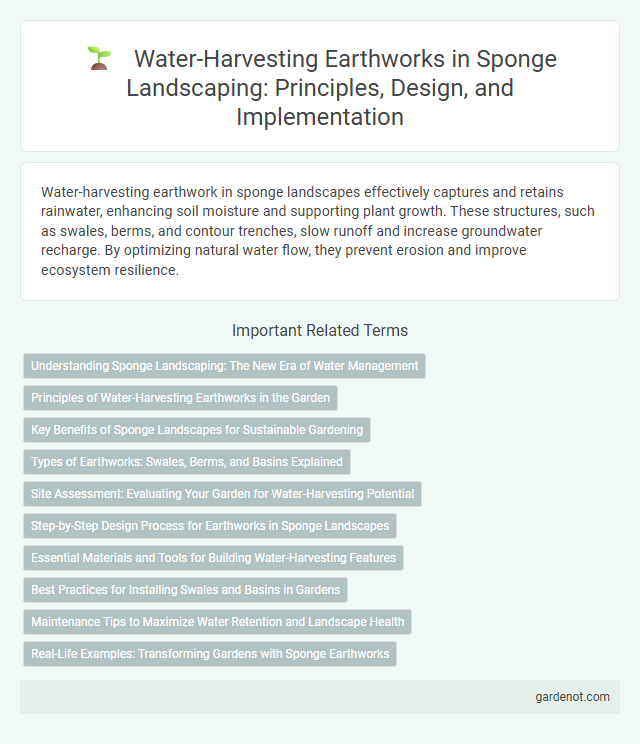Water-harvesting earthwork in sponge landscapes effectively captures and retains rainwater, enhancing soil moisture and supporting plant growth. These structures, such as swales, berms, and contour trenches, slow runoff and increase groundwater recharge. By optimizing natural water flow, they prevent erosion and improve ecosystem resilience.
Understanding Sponge Landscaping: The New Era of Water Management
Sponge landscaping revolutionizes water management by integrating water-harvesting earthworks that capture and store rainwater directly in the soil, minimizing runoff and erosion. These earthworks, such as swales and retention basins, enhance groundwater recharge, supporting sustainable irrigation and mitigating urban flooding. Implementing sponge landscaping practices promotes resilient ecosystems and efficient use of natural water resources in both residential and commercial landscapes.
Principles of Water-Harvesting Earthworks in the Garden
Water-harvesting earthworks in the garden are designed to capture, slow, and infiltrate rainwater to increase soil moisture and support plant growth. Techniques include contour swales, berms, and keyline plowing, which follow the natural topography to reduce runoff and erosion. These methods enhance groundwater recharge, promote biodiversity, and improve water efficiency in sustainable landscape management.
Key Benefits of Sponge Landscapes for Sustainable Gardening
Sponge landscapes enhance water retention by capturing and storing rainwater in strategically designed earthworks, reducing runoff and erosion while replenishing groundwater. These water-harvesting techniques support sustainable gardening by maintaining soil moisture, promoting healthy plant growth, and minimizing irrigation needs. Integrating sponge landscape principles leads to resilient green spaces that conserve water, improve biodiversity, and adapt to changing climate conditions.
Types of Earthworks: Swales, Berms, and Basins Explained
Water-harvesting earthworks in sponge landscapes include swales, berms, and basins, each designed to capture and retain rainwater effectively. Swales are shallow, vegetated channels that slow runoff and promote infiltration, while berms are raised mounds of soil that redirect water flow and create microclimates for vegetation. Basins are depressions that collect and store water temporarily, enhancing groundwater recharge and supporting local biodiversity.
Site Assessment: Evaluating Your Garden for Water-Harvesting Potential
Assessing your garden for water-harvesting potential begins with analyzing soil type, slope, and existing water flow patterns to identify optimal locations for earthworks like swales and basins. Detailed evaluation of rainfall frequency, infiltration rates, and vegetation coverage helps determine the capacity of your site to capture and retain runoff effectively. Mapping microtopography and identifying runoff sources maximize water retention efficiency in sponge landscape designs.
Step-by-Step Design Process for Earthworks in Sponge Landscapes
The step-by-step design process for water-harvesting earthworks in sponge landscapes begins with site analysis, assessing topography, soil type, and rainfall patterns to determine optimal locations for water capture and storage. Next, designers plan contour bunds, swales, and check dams to slow runoff and increase infiltration, prioritizing materials that enhance soil permeability and water retention. Final steps include detailed excavation plans and vegetation integration to stabilize structures and maximize groundwater recharge in semi-arid environments.
Essential Materials and Tools for Building Water-Harvesting Features
Essential materials for constructing water-harvesting earthworks include durable landscape fabric, high-quality geomembranes, and permeable soil amendments to enhance water retention and filtration. Key tools consist of heavy-duty shovels, trenching machines, and laser levels to ensure precise grading and efficient water flow management. Using these materials and tools optimizes the effectiveness of sponge landscapes in capturing and storing runoff water sustainably.
Best Practices for Installing Swales and Basins in Gardens
Swales and basins are essential water-harvesting earthworks that capture and infiltrate rainwater in garden landscapes, promoting soil moisture retention and reducing erosion. Best practices for installing swales include positioning them on contour lines to maximize water capture, ensuring gentle side slopes for stability, and incorporating overflow outlets for excess water management. Basins should be excavated with appropriate depth and capacity to hold runoff, lined with organic mulch to enhance infiltration, and planted with drought-tolerant vegetation to strengthen soil structure and maintain moisture.
Maintenance Tips to Maximize Water Retention and Landscape Health
Regularly inspect and clear sediment buildup in water-harvesting earthworks such as swales and basins to prevent clogging and ensure efficient water infiltration. Maintain vegetation by planting deep-rooted native species that stabilize soil and enhance water retention, reducing erosion risks. Monitor and repair any breaches or erosion promptly to sustain landscape health and maximize the sponge effect for optimal groundwater recharge.
Real-Life Examples: Transforming Gardens with Sponge Earthworks
Sponge earthworks, such as rain gardens and swales, capture and filter stormwater, significantly improving urban drainage and soil moisture retention. In real-life examples, these techniques have transformed gardens in cities like Melbourne and Cape Town, reducing runoff and promoting groundwater recharge. Integrating native vegetation within these water-harvesting systems enhances biodiversity and creates resilient, self-sustaining landscapes.
Water-harvesting earthwork Infographic

 gardenot.com
gardenot.com